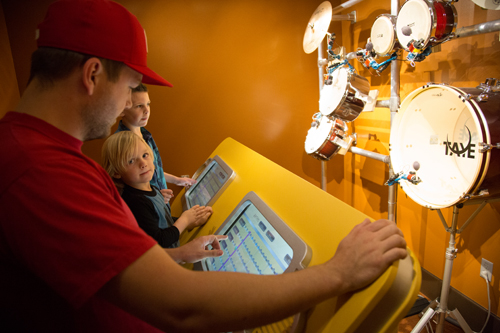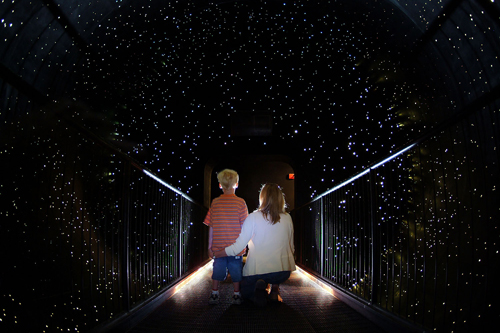EDITOR’S NOTE: Museums for All is an initiative of the Institute of Museum and Library Services, administered by the Association of Children’s Museums through a cooperative agreement with IMLS. Through Museums for All, individuals receiving food assistance (SNAP benefits) can gain free or reduced admission to more than 900 museums throughout the United States simply by presenting their SNAP EBT (Supplemental Nutrition Assistance Program Electronic Benefit Transfer) card. The following blog shares insights from one of the Museums for All participating museums.
July 13, 2022
Kari Ross Nelson, Research and Evaluation Associate
Stephen Ashton, Director of Audience Research and Evaluation
Background

Families make a beat in the Kidopolis Music Room, one of 500 interactive exhibits in the Museum of Natural Curiosity. (Photo courtesy of Thanksgiving Point Institute).
Thanksgiving Point Institute is a five-venue, farm, garden, and museum complex in Lehi, Utah – about 30 miles south of Salt Lake City. We began participating in Museums for All in November 2019. After a slow start in 2020, our numbers began to rise in 2021 and we now regularly welcome more than 1,500 Museums for All visitors each month.
Thanksgiving Point wanted rich data—beyond attendance numbers– to show how the program is serving visitors. Although the Association of Children’s Museums consolidates and provides data to participating museums that is helpful in comparing their numbers with other participating museums, there is much to be learned from the Museums for All visitors themselves. At Thanksgiving Point, our Audience Research and Evaluation team set out to collect this visitor data for our institution.
The Survey
We decided to create a survey that could be completed anonymously to respect the confidentiality of Museums for All visitors. The survey includes:
-
Questions to help us understand how often people visit museums with and without the Museums for All opportunity;
-
Satisfaction questions like in our ongoing monthly exit survey to allow for comparisons;
-
Impact questions borrowed from and validated by the Measurement of Museum Social Impact study we’re working on at Thanksgiving Point (see org);
-
Open ended questions inviting people to share memories and any other comments they have;
-
A few demographic questions such as race, gender, and group size.
We wrote the survey for a 5th grade reading level which is recommended by Calderon and Morales (2006) as a very easy reading level and offered it in both English and Spanish. The survey was distributed through the Qualtrics online survey platform.
Distributing the Survey
At Thanksgiving Point, we extend Museums for All benefits to both SNAP (Supplemental Nutrition Assistance Program) and WIC (Special Supplemental Nutrition Program for Women, Infants, and Children) participants. Representatives from the U.S. Department of Agriculture offices that sponsor these programs advised us not to ask in person for email addresses and also that, while many participants may not have computers or internet access at home, most have smartphones. With this in mind, we created an invitation flyer (in both Spanish and English) with a QR code to access the survey. Guest Services staff were instructed to hand the flyer to each Museums for All visitor and give a quick, simple invitation such as “We’d love to hear how the Museums for All program is working for you. Here is some information about a survey.”
Findings

We started inviting people to take the survey in mid-December 2021. As of this writing, we have 67 responses to the survey – about a 10 percent response rate. Though we can’t make any significant claims from the data at this point, there are some clear and positive trends emerging:
The program appears to be encouraging repeat visits. More than half of respondents say they have been to Thanksgiving Point Museums three or more times.
The program appears to increase access to museums. 70 percent say they visit other museums two or fewer times per year.
All respondents said they were “happy” or “very happy” with their visit (none said neutral, unhappy, or very unhappy!) and the likelihood that they will recommend the museum to others is higher in this survey than in our ongoing monthly exit survey of visitors generally.
All respondents somewhat or strongly agreed that visiting helped them…
- see how exploration leads to learning.
- think about the good things in their lives.
All respondents felt…
- encouraged to spend more time with friends and family.
- welcome at Thanksgiving Point.
- that Thanksgiving Point employees were helpful.
And finally, a few quotes:
“Thank You very much!! It is always fun & heartwarming to witness people have experiences for the first time.We learn or notice or learn something new each time we visit!”
“I appreciate the kind worker that helped me at the welcome desk. I didn’t catch her name, but she was very welcoming. She made me want to come back again and again. Thank you for encouraging learning and making me feel like I’m doing the best thing I can for my son.”
“I'm so grateful for the WIC program allowing me to come! It’s too expensive for me and many of my friends. But with this WIC program I can bring family, friends, and my kids. Thank you! Each museum is extremely interactive and educational. It gets me out of the house and gets the kiddos learning and healthily engaged. And there's always lots of kids so it's a perfect opportunity for my 1-year-old to socialize. I love this program and Thanksgiving Point!”
“Thank you for making it affordable to visit. This was the first time in the last year that we could afford to visit a museum.”
Next Steps
We are encouraged by the responses we have received thus far, and they are beginning to fill the call for rich data our development team asked for. As our field looks for ways to demonstrate the impact of museums on the communities they serve, we are considering ways we might scale up this survey project to represent the field broadly. We invite your suggestions for ways to improve on our initial efforts, as well as interest in collaborating on the next iteration.
Kari Ross Nelson is Research and Evaluation Associate and Stephen Ashton, PhD, is the Director of Audience Research and Evaluation at Thanksgiving Point in Lehi, Utah.
Reference
Calderon, J. L., Morales, L. S., et al. (2006). Variation in the readability of items within surveys. American Journal of Medical Quality,21(1), 49–56.